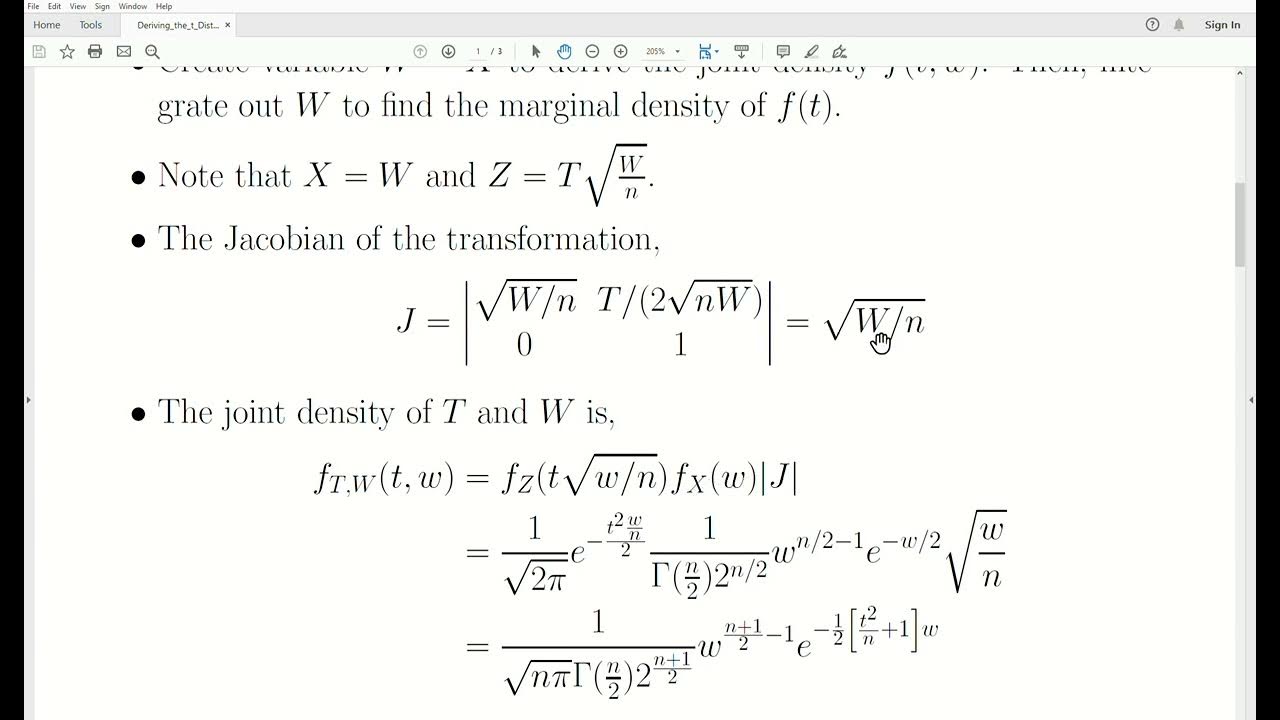What is the Chi-Squared distribution? Extensive video!
Summary
TLDRIn this educational video, Justin Zeltser explores the chi-squared distribution, its history, derivation from the normal distribution, and its properties. He explains how it's formed by squaring values from a standard normal distribution and summing them, influenced by degrees of freedom. Zeltser delves into the expected value and variance, proving they are K and 2K respectively. The video also visually demonstrates how the distribution's shape changes with varying degrees of freedom, aiming to deepen viewers' intuition and understanding of statistical concepts.
Takeaways
- 📚 The chi-squared distribution is denoted by the Greek letter Chi (χ) squared, and it's represented as a curly X with a 2 after it.
- 👨🔬 The chi-squared distribution was 'discovered' twice, first by Frederick Robert Helmert in 1875 and then independently by Karl Pearson in 1900.
- 🔄 The chi-squared distribution is derived from the normal distribution, specifically from the squaring of values from a standard normal distribution.
- 📊 The shape of the chi-squared distribution is determined by its degrees of freedom, which affects how the data is distributed and the curve's tail length.
- 🧮 A chi-squared distribution with one degree of freedom is created by squaring a single value from a standard normal distribution.
- 🔢 As the degrees of freedom increase (e.g., two, three, etc.), the chi-squared distribution becomes more spread out and has a longer tail.
- 📈 The mean of a chi-squared distribution is equal to the number of degrees of freedom (K), and the variance is 2K.
- 📚 The video provides an intuitive explanation of why the mean and variance of the chi-squared distribution are related to the degrees of freedom.
- 🔍 The script discusses the concept of kurtosis, which is related to the 'fatness' of the tails in a distribution, and its role in calculating the variance.
- 🎓 The video is part of a series that covers various statistical topics, including regression, descriptive statistics, and statistical inference.
Q & A
Who discovered the chi-squared distribution?
-The chi-squared distribution was discovered independently by two individuals: Frederick Robert Helmert, a German mathematician in 1875, and Karl Pearson in 1900.
What is the Greek letter used to represent the chi-squared distribution?
-The Greek letter used to represent the chi-squared distribution is 'Chi', which looks like a curly 'X' with a '2' after it, denoted as χ².
How is the chi-squared distribution derived?
-The chi-squared distribution is derived from a standard normal distribution (Z distribution) by squaring the values and considering the distribution of those squares.
What is the relationship between the chi-squared distribution and the number of degrees of freedom?
-The chi-squared distribution is defined by its number of degrees of freedom, which determines the shape of the distribution. The more degrees of freedom, the broader and longer the tail of the distribution.
What is the expected value of a chi-squared distribution?
-The expected value of a chi-squared distribution is equal to the number of degrees of freedom (K).
What is the variance of a chi-squared distribution with K degrees of freedom?
-The variance of a chi-squared distribution with K degrees of freedom is 2K.
How is the shape of the chi-squared distribution affected by the number of degrees of freedom?
-As the number of degrees of freedom increases, the shape of the chi-squared distribution becomes more spread out, with a longer tail and a peak that moves further away from zero.
What is the intuition behind squaring values from a normal distribution to create a chi-squared distribution?
-Squaring values from a normal distribution emphasizes the values further from the mean, as squaring reduces the influence of values close to zero and increases the influence of values further from zero.
Why is the chi-squared distribution important in statistical analysis?
-The chi-squared distribution is important in statistical analysis because it is used in hypothesis testing, particularly in tests like the chi-squared goodness of fit test and the chi-squared test for independence.
What are some practical applications of the chi-squared distribution mentioned in the script?
-Some practical applications of the chi-squared distribution include the chi-squared goodness of fit test and the chi-squared test for independence, which are used to analyze categorical data and assess the relationship between variables.
Outlines

Cette section est réservée aux utilisateurs payants. Améliorez votre compte pour accéder à cette section.
Améliorer maintenantMindmap

Cette section est réservée aux utilisateurs payants. Améliorez votre compte pour accéder à cette section.
Améliorer maintenantKeywords

Cette section est réservée aux utilisateurs payants. Améliorez votre compte pour accéder à cette section.
Améliorer maintenantHighlights

Cette section est réservée aux utilisateurs payants. Améliorez votre compte pour accéder à cette section.
Améliorer maintenantTranscripts

Cette section est réservée aux utilisateurs payants. Améliorez votre compte pour accéder à cette section.
Améliorer maintenantVoir Plus de Vidéos Connexes

Deriving the t Distribution

Distribusi Normal | Konsep Dasar dan Sifat Kurva Normal | Matematika Peminatan Kelas 12

#4 Uji Normalitas Chi Square dengan Excel - Statistika Pendidikan

Tutorial 11- Log Normal Distribution Explained In Hindi

Metode Statistika | Sebaran Peluang Kontinu | Mengenal Sebaran Normal

Math 220 Sec 8 5 Part 1
5.0 / 5 (0 votes)
